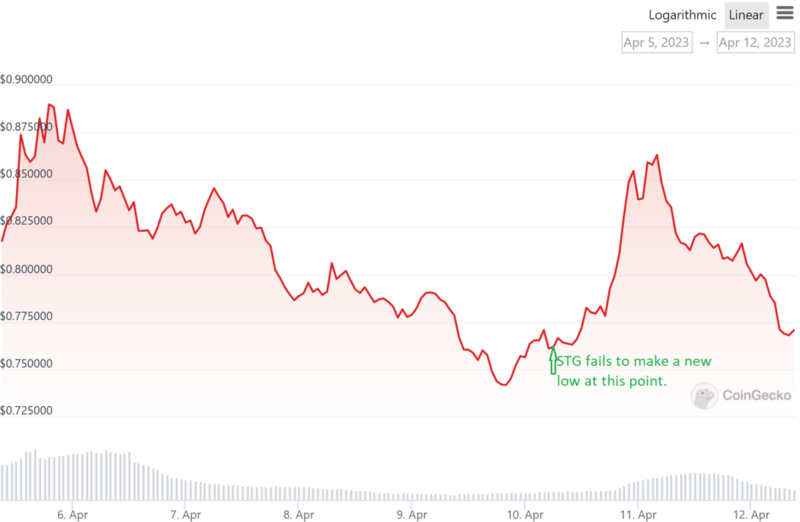Key takeaways
A swing failure pattern is a technical indicator used in trading to signal a trend reversal.
It occurs on uptrends and downtrends, indicating sell and buy respectively by allowing investors to detect weakness in an existing trend and early reversal signals.
A bullish swing failure pattern is mainly observed in an uptrend and is characterized by a failed attempt to make a higher high, followed by a break below the most recent swing low.
A bearish swing failure pattern is typically in a downtrend and is characterized by a failed attempt to make a lower low followed by a break above the most recent swing high.
Swing failure patterns are not always reliable and should be used in conjunction with other technical analysis tools and indicators to make informed investment decisions.
The Swing Failure Pattern (SFP) is an important technical indicator commonly seen in overbought and oversold zones. It is a pattern used in technical analysis, which aims to project price movement using historical asset price and volume data. Technical analysis is best used in conjunction with fundamental analysis, which provides a broad picture of the market, using financials, user base, geo-political activities, and real-world utility to predict future crypto price movement.
This guide defines a swing failure pattern in crypto trading, what it looks like, the best time frame to trade swing failure patterns, bullish swing failure patterns and bearish swing failure patterns.
What is the swing failure pattern in trading?
The Swing Failure Pattern (SFP) is used in technical analysis by traders to identify potential trend reversals. It indicates when the prevailing market trend weakens, and another trend emerges. SFPs are found in bullish and bearish markets and are often used by swing traders, who aim to capitalize on short-term price movements.
SFP usually occurs when the price of an asset fails to make a new high or low despite a strong move in the opposite direction. For example, in a bullish market, the price may make a new high, but fail to make another high on the next swing, despite a strong move in the opposite direction. This failure to continue the uptrend is seen as a sign that the trend may reverse.
In the image above, the asset fails to make a new high, leading to a trend reversal.
In the image above, the asset fails to make a new low, leading to a trend reversal.
After identifying an SFP, you can take a position against the prevailing trend. For example, in a bullish market, you can short as soon as you identify an SFP, expecting the market to reverse and move lower. Likewise, you can buy into a bearish market as soon as you spot the pattern, expecting the market to change and move higher.
The swing failure pattern is important because it can help you identify potential trend reversals and capitalize on short-term price movements. By identifying the patterns, you can enter and exit trades at the optimal time, maximizing your profits and minimizing losses.
However, it is important to note that, like all technical analysis tools and indicators, the SFP is not infallible. Cryptocurrencies are quite unpredictable, and trends can reverse unexpectedly. Therefore, you should always use proper risk management techniques, such as setting stop loss orders, to limit losses if the market moves against your plan.
How to Identify a Swing Failure Pattern
Identifying an SFP is useful, especially if you want to capitalize on short-term price movements and potential trend reversals. Follow the steps below to detect a Swing Failure pattern:
1. Identify the prevailing trend
The first step in identifying a swing failure pattern is to determine the prevailing trend – is it an uptrend or a downtrend? You can accurately identify a prevailing trend using technical analysis tools, such as moving averages, trend lines, or chart patterns.

2. Look for a strong move in the opposite direction
After identifying the current trend, look for a strong move in the opposite direction. This move should be significant enough to signal a potential trend reversal.
3. Watch for a failure to make a new high or low
After seeing a solid move in the opposite direction, watch for a failure to make a new high or low. This failure indicates that the market may be losing momentum and that a reversal may occur.

4. Confirm the pattern with other indicators
You can use other technical analysis tools, such as momentum indicators, volume indicators or candlestick patterns, to confirm the formation of an SFP.
5. Law
After confirming the formation of an SFP, you can act by entering a position in the opposite direction of the prevailing trend. For example, if the prevailing trend is bullish, you should short your trade in anticipation of a trend reversal.
In general, identifying an SFP requires the combination of technical analysis tools and careful observation of price movements. By following the steps outlined above, you can spot potential trend reversals and capitalize on short-term price movements.
What time frame is best for trading swing failures?
The best time frame for swing failure pattern trading depends on your style and preferences. Some traders prefer shorter time frames, such as 5-15 minute charts, while others prefer longer ones, such as daily or weekly charts.
In general, swing trading involves holding positions for several days to weeks, making it more suitable for longer time frames. Therefore, daily or weekly charts can be ideal for identifying potential trend reversals.
However, you can also use shorter timeframes for SFP trading, especially if you prefer a more active trading style. In this case, you can use 1-hour or 4-hour charts to identify swing failure patterns and take advantage of short-term price movements.
Ultimately, the best timeframe for SFP trading depends on your strategy, risk tolerance and preferred trading style. Furthermore, regardless of your time frame, you should always use proper risk management techniques, such as setting stop loss orders, to limit losses if the market moves against you.
Bullish Swing Failure Patterns
Bullish swing failure patterns are chart patterns often used in technical analysis to identify potential changes in the trend of an asset in trading. They are typically observed in uptrends and are characterized by failed attempts to make higher highs, followed by breaks below the most recent swing lows.
The bullish swing failure patterns are considered a sign of weakness in an uptrend, indicating that the bulls are losing momentum and the bears are strengthening. These patterns are also known as “bull traps” because they can lure unsuspecting investors into buying, only to be caught in a losing trade when the trend reverses.
You typically need to look for two key components to identify a bullish swing failure pattern. The first component is a clear uptrend with a series of higher highs and higher lows. The second component is a failed attempt to make a higher high followed by a break below the most recent swing low.
After identifying these components, you can look for other signs of weakness in the uptrend, such as a bearish divergence in the momentum indicators or a pattern of lower highs and lower lows in the price action. These additional signals will help confirm the potential trend reversal and provide more confidence in shorting an asset.
It is important to note that bullish swing failure patterns are not always reliable and should be used in conjunction with other technical analysis tools and indicators. You should also be aware of the potential risks of trading against a strong uptrend and apply appropriate risk management techniques, such as setting stop loss orders and managing position size to avoid missing out on profitable opportunities.
Bearish Swing Failure Patterns
Like bullish swing failure patterns, bearish swing failure patterns are chart patterns commonly used in technical analysis to spot potential changes in the trend of an asset. They are often observed in downtrends and are characterized by failed attempts to make lower lows followed by breaks above the most recent swing highs.

Most traders see bearish swing failure patterns as signs of weakness in downtrends, indicating that the bears are losing momentum and the bulls are strengthening. These patterns are also known as “bear traps” because they can entice unsuspecting investors to sell, only to be caught in a losing trade when the trend reverses.
You need to look for two key elements to identify a bearish swing failure pattern. The first one is a clear downtrend with a series of lower lows and lower highs. The second component is a failed attempt to make a lower low followed by a break above the most recent swing high.
After confirming both elements, look for other signs of weakness in the downtrend, such as a bullish divergence in the momentum indicators or a pattern of higher highs and higher lows in the price action. These additional signals will help confirm the potential trend reversal and explain your decision to desire an asset.
Closure
Swing Failure Pattern is a technical analysis tool used in trading to identify potential trend reversals. It indicates when the prevailing market trend weakens, and another trend emerges. Although this pattern is not 100% foolproof, it is a simple and effective technical indicator for identifying trend reversals. By understanding and making use of it, you will be able to identify potential trend reversals and take the necessary action,
Tell us how much you like this article!
Josiah Makori
Josiah is a tech evangelist who is passionate about helping the world understand Blockchain, Crypto, NFT, DeFi, Tokenization, Fintech and Web3 concepts. His hobbies are listening to music and playing football. Follow the author on Twitter @TechWriting001
Read more about Josiah Makori
Disclaimer for Uncirculars, with a Touch of Personality:
While we love diving into the exciting world of crypto here at Uncirculars, remember that this post, and all our content, is purely for your information and exploration. Think of it as your crypto compass, pointing you in the right direction to do your own research and make informed decisions.
No legal, tax, investment, or financial advice should be inferred from these pixels. We’re not fortune tellers or stockbrokers, just passionate crypto enthusiasts sharing our knowledge.
And just like that rollercoaster ride in your favorite DeFi protocol, past performance isn’t a guarantee of future thrills. The value of crypto assets can be as unpredictable as a moon landing, so buckle up and do your due diligence before taking the plunge.
Ultimately, any crypto adventure you embark on is yours alone. We’re just happy to be your crypto companion, cheering you on from the sidelines (and maybe sharing some snacks along the way). So research, explore, and remember, with a little knowledge and a lot of curiosity, you can navigate the crypto cosmos like a pro!
UnCirculars – Cutting through the noise, delivering unbiased crypto news

.png?1681723721)









